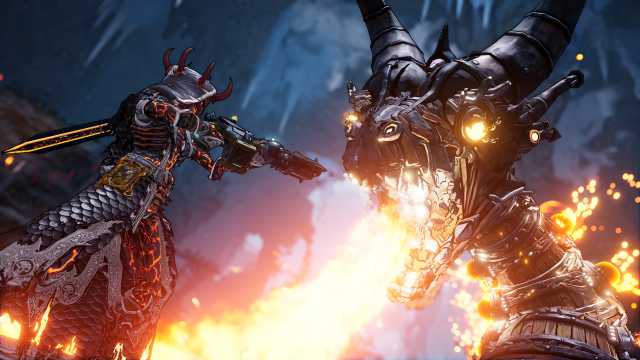Tiny Tina’s Wonderlands feels like Borderlands draped in a Kmart robe and wizard’s hat.
There’s good and bad in that. Let’s explore a bit of each.
Tiny Tina’s Wonderlands is a spin-off of the Borderlands franchise, and more specifically the Borderlands 2 DLC Assault on Dragon Keep. That DLC is considered the narrative high-watermark in Borderlands canon. Through the lens of a tabletop roleplaying game based on Dungeons & Dragons, it explored the special grief that follows the death of a friend and mentor.
Tina (played by Horizon: Forbidden West’s Ashly Burch) poured all of her grief, denial, and unexamined trauma into a game for her friends. She had to be dragged by the player, kicking and screaming, to self-actualisation. Assault on Dragon Keep is one of the only times the Borderlands series has successfully landed an emotionally resonant narrative beat. There is, as we know, no series in all of video games so eager to sabotage itself with its own terrible sense of humour. For this one beautiful campaign, Gearbox was able to reign itself in for the greater good.
Union dues
I feel like Tiny Tina’s Wonderlands may not reach quite the same dizzying narrative heights. One of the two major sections I was able to play through in the preview build appeared to be a riff on the Harry Potter house elf resistance plotline? S.P.E.W.? Remember that? Wonderlands’ take on the material is that a goblin union, the G.T.F.O (or Goblins Tired of Forced Oppression)., is being subjugated and forced to work as slaves in a mine for bigger, meaner creatures than themselves.

My job was to liberate the goblins. Each goblin I rescued would use its newfound union solidarity to cheer excitedly about no longer having to work, and do indeed GTFO, departing the scene at high speed. I understand the impulse. I too do not dream of labour.
For the sake of spoilers, I won’t go too deeply into the wider plot of this section. What I will say is that Gearbox may live to regret the decision to launch a game that centres a parody labour movement in a moment when the real world games industry grapples with systemic workplace abuse and growing calls for workers’ rights and industry unionisation.
Video games take a long time to make. There’s no way to know what the industry landscape will look like when a game of Wonderlands’ size enters pre-production. Maybe it really was just a harmless Harry Potter reference, and now it’s accidentally taken on a new significance. Regardless, if Gearbox were attempting some sort of veiled shot at games industry practices, it might benefit them to be a little more careful.

I look forward to the takes when the game launches later in the month.
So that’s the less-good part. Let’s talk about the things it does well.
Just give me the guns
The first thing I noticed about my preview build was that it ran a great deal more smoothly than Borderlands 3 did at launch. Borderlands 3 was in a right state when it first arrived, performance issues dogging the game on even the most powerful gaming PCs. The preview build I spent time with last week was in much more refined condition. The game ran smoothly, with no frame drops or bottlenecking.
The shooting and looting, the best part of the Borderlands experience, carries over. Wonderlands’ weapons handle in functionally the same ways as those in Borderlands, they’re just draped in fantasy garb.

In both accessible sections, I was given guns right on the edge of viability. Borderlands fans are familiar with this feeling when the enemies start to ever-so-slightly out-level you. The nudge from Gearbox was clear. Go look for some better ones. So I did. In terms of the weapons I found, it was the snipers that remained the most valuable to me, allowing my squishy character to keep their distance. The shooting still feels great and the enemy variety kept me on my toes. Gearbox has always been very good at this aspect of the Borderlands model and Wonderlands doesn’t seem to fall far from the tree. That’s a wise move.
The game’s classes are ripe for game-breaking build combinations, and this is the part of the Borderlands experience that’s always stuck out to me. I love finding guns and skill synergies that turn my character into a world-destroying engine of raw DPS. Though I only had limited access to level ups and classes, a brief perusal of each tree quickly put my brain to work. Of everything I saw in the hands-on preview build, this is the facet that piques my interest more than anything else.

One change from the standard Borderlands experience that helps Wonderlands take on a personality of its own is that it changes grenades and standard melee attacks out for magic spells. They’re used in the same way, and it’s ultimately a small change, but the flavour is there and I appreciate it.
Vibe check?
In the end, the takeaway for me is that Tiny Tina’s Wonderlands is simply More-derlands. It’s three Psycho Tinks stacked on top of each other in a wizard’s robe they stole from a costume shop. The shooter and RPG fundamentals still feel very strong and fun to manipulate.
Gearbox may find it’s accidentally put its foot in it with the union thing, and its attempts at humour still grate, but the ARPG stat tweaking and the moment-to-moment shooting is still very enjoyable.

Leave a Reply